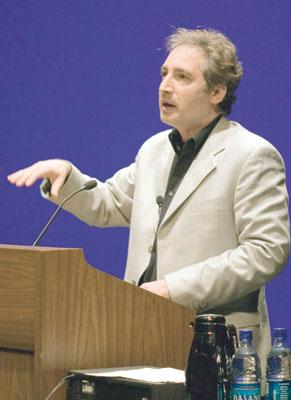Strings, “branes” and the big splat: Are we talking about Nickelodeon here, or the fabric of the universe?
Renowned Columbia University physicist Brian Greene spent Monday on campus, illustrating the cutting-edge physics of superstring theory, which reconciles conflicting laws of physics and offers insights into the origin of the universe — among other notable phenomena.
Also known simply as string theory, this unproven body of mathematical knowledge suggests that “all the various particles in physics arise from different modes of vibration of a single kind of string,” Greene said.
Strings, if they exist, are little filamentous loops that vibrate in 10 dimensions of space, and could be the basic stuff that all matter and energy are made. They also give rise to phenomena called membranes (“branes”). The origin of the universe may have resulted from the collision between two membranes — known as the big splat.
For all their explanatory power, strings can be a little hard to envision.
According to Greene, the crucial behavior of strings occurs on the scale of “100 billion times smaller than the atomic nucleus.” At this level, strings reconcile two accepted but conflicting theories: General relativity, which requires space to behave “gently and smoothly” and quantum mechanics, which describes space as “jittery, frenzied, turbulent and frothy,” Greene said.
Not only do strings operate on a mind warping small scale, they demand the universe to have seven extra microscopic dimensions of space, known as “curled-up dimensions.”
It might be tempting to take an aspirin and leave the whole confusing mess behind as Greene himself pointed out that string theory is a little obscure.
“If you don’t work with black holes and the big-bang, this is not really an issue you have to deal with in your everyday life,” he said.
Nonetheless, students were clearly ready to do some mind-bending on Monday: Greene’s physics colloquium, part of the Physics Department’s L. H. Thomas lecture series, was delivered to a standing-room only audience in a lecture hall with a seating capacity of 244 people.
The evening lecture, tailored to a non-physicist audience, was sold out in Stewart Theater.
Greene argues that string theory, despite its esoteric nature, really should matter to so many people.
“What we are trying to do in science is not just to model, it’s to find the truth,” he said. “If your models are in conflict with one another, like general relativity and quantum mechanics, you have to keep going. Until you resolve this conflict you will not be able to understand how the universe began. Thankfully, we now have a theory that does that.”
It also helps that Greene has authored two popular physics books and hosted a three-part NOVA television series.
“He is the most well-known physicist out there,” Paco Robles, a junior in physics, said.
Greene’s gift for communication makes invisible strings and curled up dimensions seem almost accessible. He rolls up a piece of paper so its third dimension disappears, demonstrating how an invisible extra dimension might exist. He gestures with animation, shoving hypothetical atoms and strings through the air in front of him. He shows psychedelic screensaver-like video clips that illustrate how strings work.
“He really broke it down in an interesting way,” Adam Atarian, a senior in math, said. “And people like string theory because it explains so much. But it has a lot of detractors, too. If other physicists were as good at breaking it down for such a wide audience, string theory might not be as popular.”
Other audience members added that the appeal of string theory lies in its ability to explain the very small and the very large in a consistent way that makes sense.
“What he says explains the whole universe on a very small scale,” Camilo Alvarez, who will be a student in electrical engineering next semester, said Alvarez traveled from Wilmington to attend Greene’s lectures.
Elizabeth Bradford, a junior in art and design, also noted the universal allure of space and time.
“This kind of physics is about what the world is made of,” Bradford said while she waited in line for Greene’s autograph. “That’s a thing that’s interesting to everybody.”








